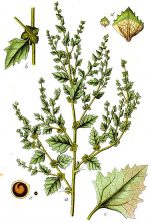 Also known as red orach, redscale, and tumbling orach, this annual shurb is native to Eurasia but as been introduced to many areas including the US especially in the West. It is a member of the Amaranthaceae family that also includes spinach, beet, and celosia. Plants grow up to 4.5′ tall and have erect, hairless branching stems and green to red leaves with three prominent veins and a whitish mealy coating at least on the lower surface. Each leaf is 1-2.4″ long, oval to triangular or lanceolate, and has wavy to toothed margins. Axillary glomerules or interrupted terminal spikes of small inconspicuous female and male flowers appear on the same plant from mid summer to fall. The staminate flowers have a 5-parted perianth and are carried on the upper parts of the stems. The pistillate flowers lack a perianth and have 2 subtending bracts that are fused for less than half their length and have sharp projections on their sides. The fruit is a utricle containing brown to black seeds. Photo Credit Wikipedia
Also known as red orach, redscale, and tumbling orach, this annual shurb is native to Eurasia but as been introduced to many areas including the US especially in the West. It is a member of the Amaranthaceae family that also includes spinach, beet, and celosia. Plants grow up to 4.5′ tall and have erect, hairless branching stems and green to red leaves with three prominent veins and a whitish mealy coating at least on the lower surface. Each leaf is 1-2.4″ long, oval to triangular or lanceolate, and has wavy to toothed margins. Axillary glomerules or interrupted terminal spikes of small inconspicuous female and male flowers appear on the same plant from mid summer to fall. The staminate flowers have a 5-parted perianth and are carried on the upper parts of the stems. The pistillate flowers lack a perianth and have 2 subtending bracts that are fused for less than half their length and have sharp projections on their sides. The fruit is a utricle containing brown to black seeds. Photo Credit Wikipedia
The Hebrew word מַלּ֣וּחַ and is often translated as mallows because of the similarity of the Hebrew word to the Greek word malache (implying salty), from which the Latin malva and English “mallow” are derived. It is not related to the plant we ordinary call mallow, Malva sp. Most authorities believe that a kind of saltbush, Atriplex, is intended. Twenty one kinds of saltbush are found in the Holy Land and any one of them could be the plant intended. Although Atriplex halimus is the most probably species, other possibilities A. rosea (tumbling saltbush), A. dimorphostegia, and A. tatarica (tatarian orachea).
Job 30.4 (NKJV) Job bemoans his miserable plight by describing the very poor food that is eaten by the lowly, unworthy people that are now his tormentors.
“Who pluck mallow by the bushes, And broom tree roots for their food.”
Tumbling saltbush prefers full sun and average to lean, medium moist to dry, well-drained soil in USDA Hardiness Zones 2-9, but tolerates saline and very alkaline soils. Plants are generally healthy and have no significant pests or diseases. Propagation is by seed. The plant has been harvested from the wild for local use as a food, medicine and source of potash .
The genus name, Atriplex, is the Greek name for orach, a related plant that can be used as spinach. The specific epithet, rosea, is the Latin word meaning rose-colored, and refers to the leaves.